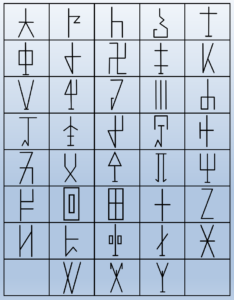Here’s an interesting thought about the influence of geography on writing.
Colonial scripts may be used in several countries, even dozens of countries, without varying a great deal from place to place—because these outposts are manifestations of a central and coherent authority.
Indigenous and minority scripts may also be found in multiple locations, but they may vary so greatly as to be entirely different scripts that have struggled to survive in small pockets of refugee cultures. Scattered and disadvantaged, they may have no communication with other pockets of their kin, let alone any central authority.
In South and Southeast Asia this is especially true because of the terrain: the Hmong, the Gurung, the Karen, fleeing from the armies of larger and more powerful cultures, have found new upland or jungle homes where they can, and in those homes have adapted or even invented scripts for themselves.
The Karen language, for example, is variously written in several scripts closely related to Burmese, their ancestral home: Eastern Pwo Karen, Western Pwo Karen, S’Gaw Karen, and Letalanyah, the last of which was invented by a Buddhist monk in the 1960s for use in Karen State in Myanmar, but is still very Burmese in appearance.
Three scripts, though, are very different. One is the Leke “Chicken Scratch” script; another is the Thai-like Kayah Li script; the other is Lekwaikaw or Kwekaw. All three are highly local, one being used specifically by practitioners of the Leke religion, one has flourished in the harsh conditions of refugee camps in Thailand, and the other … well, I’m not sure yet.
Lekwaikaw can be used to write both S’gaw Karen and Pwo Karen, which in itself is interesting, as it suggests the script has travelled, or was created with flexibility in mind.
Speaking of which–what are its origins?
According to ChatGPT, definitely not a reliable source, the script was created by Saw Aung Hla in 1962. This seems unlikely, as Saw Aung Hla, the main intellectual figure among the Karen writers of Burma and Thailand, died in 1939.
Lekwaikaw was reportedly first used (and may have been invented) by Popular Karen Nationalist Buddhist monk U Thuzana, also known as Myainggyingu Sayadaw (1947-2018), a Karen Theravada Buddhist monk based in Myaing Gyi Ngu, Kayin State, Myanmar. He was the leader of the Democratic Karen Buddhist Army, an ethnic insurgent group, until its dissolution in 2010. Lekwaikaw is reportedly now widely used by his follower communities and circles.
Atsuhiko Kato conducted a linguistic analysis of the script and the language and concluded that as the script corresponds to the current state of the spoken language, it is unlikely to be an ancient script.
I have rarely felt that the information we’re providing you is more provisional. Stay tuned.

17.3588° N, 97.6738° E